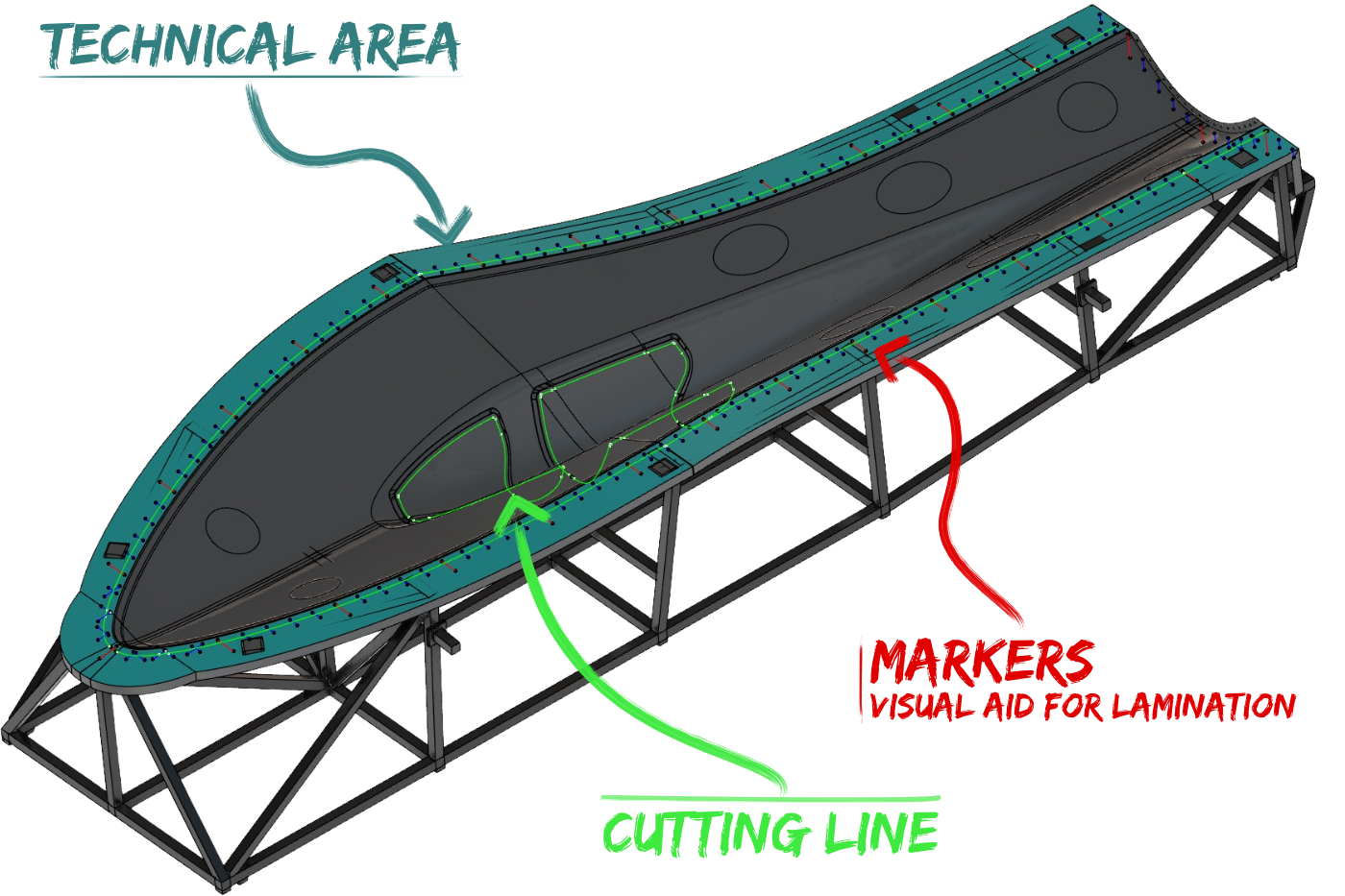The construction process: from pictures to the final boat #1
April 20 2022
Building a carbon-made boat able to break the world sailing speed record is the result of a collaboration between SP80, North Thin Ply Technology, Persico Marine and Sinergia Racing Group. The four players have interacted throughout the whole construction process, one with many steps that have all led to the final product.
In this series of articles, we will show you the different production steps, from mold creations to the final assembly of parts, necessary to the construction of our record-breaking boat.
The molds: to foresee the construction as much as possible
The first crucial step in our construction process is the design and production of molds that will hold our final parts. For this, two parameters must be set:
- The shape of the boat;
- The material used for the mold.
While the first point depends mainly on considerations related to the boat’s performance and ability to reach 80 knots (150km/h), the second one corresponds to more practical criteria. Indeed, it’s essential to have our mold made from the same material as our boat: carbon. This way, during curing, parts won’t distort differently to the molds under the effect of thermal dilation. We can therefore guarantee a perfect outer surface and geometry.
CARBON EXPLAINED IN VIDEO

Beyond shape and material, molds must also contain certain features to help the shipyard produce the final parts. The first one is the addition of a technical area: an edge of about 100mm that extends around the mold. This allows the joint used during vacuum sealing or lamination (i.e. the application of carbon layers in the molds to create the final part) to be glued.
The second feature is a visual aid for the lamination and future assembly of the parts: a series of markers are engraved which help with the positioning of the carbon plies, foam, as well as with the alignment of the different parts.
At this stage, it’s therefore necessary to put ourselves in the shipyard’s shoes to anticipate their needs during the construction.

But how do we make a mold?
Our partner Sinergia Racing Group is a specialist in that field and has a well-proven process. After having received our desired geometry, they start by producing a block of foam which will serve as a support to make the carbon molds.
Once the block is ready, they apply several layers of carbon permeated with resin by infusion. In our case, the molds have an average thickness of 8mm to ensure they won’t deform. In addition, they are positioned on a steel structure specially designed for their geometry. Once the process is complete, the mold is almost ready to use!
Overview of the different techniques of composite processing
Composite is the association of a dry fabric (carbon, fiberglass, aramid, etc.) with a liquid resin, which will give a compact and hard set. There are different techniques, and we will focus on the 3 main ones used in the maritime world:

Infusion at the shipyard – © Persico Marine
Overview of the different techniques of composite processing
Composite is the association of a dry fabric (carbon, fiberglass, aramid, etc.) with a liquid resin, which will give a compact and hard set. There are different techniques, and we will focus on the 3 main ones used in the maritime world:
Contact molding
Dry fabrics are hand-basted with resin one after the other and stacked. Although it’s possible to remove some of the excess, this method often results in an excessive amount of resin and therefore a part with poorer quality: the fibers in the fabric being more resistant than the resine, it’s essential to have the minimum quantity of resin on the fabric.
Infusion
The number of dry fabrics required to make the part is stacked, then packed in a tarpaulin. On one side, the resin is injected and on the other side the air is sucked out creating a vacuum. The resin will slowly migrate to the air suction side until it has saturated all the tissue. This method is the most widespread because it is the best in terms of composite quality/price ratio.
Pre-impregnated
The exact amount of resin required is first combined with the fabric. Pre-impregnated fabrics must be kept in a cool environment to prevent the resin from hardening at room temperature. Once removed from the freezer, they are simply stacked together. These more expensive prepregs provide better properties for the final part.

Infusion at the shipyard – © Persico Marine
“Almost ready” because it has to undertake a series of tests to ensure that it complies with our requirements. The mold has to pass:
- A drop test to verify it is airtight. To do this, a tarp is used to cover the mold and is then vacuum packed. The pressure is read every minute for half an hour with a manometer. If it remains below a targeted value, the test is validated!
- A post-curing, to ensure that it will withstand future curing temperatures. The risk of omitting this step is that the resin contained within the mold will partially soften causing the mold to deform, endangering the part itself.
- A 3D scan, to guarantee a good tolerance compared to the predetermined geometrical shape.
Foam block – support for our main hull’s mold
© Sinergia Racing Group
Conclusion
Once the mold has successfully passed all the tests, it’s ready to be sent to Persico Marine for the realization of the final phase! Stay tuned for the next steps…
Stay tuned!
Copyright 2024 | SP80 | Tous Droits Réservés

